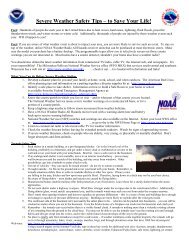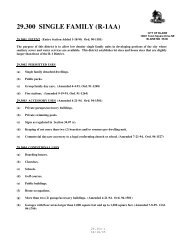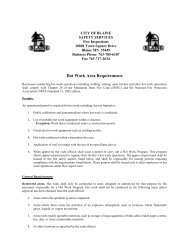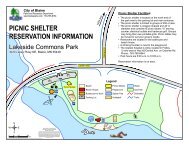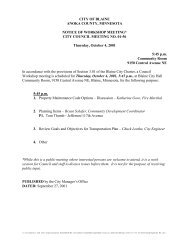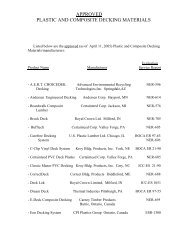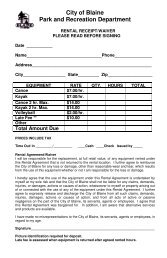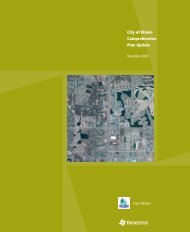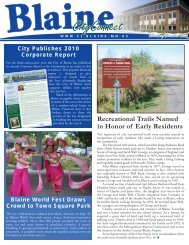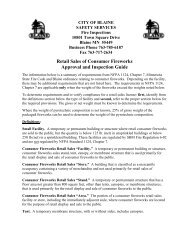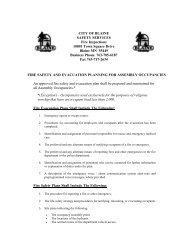Download PDF - Blaine, Minnesota
Download PDF - Blaine, Minnesota
Download PDF - Blaine, Minnesota
You also want an ePaper? Increase the reach of your titles
YUMPU automatically turns print PDFs into web optimized ePapers that Google loves.
2012 Drinking Water Report<br />
The City of <strong>Blaine</strong> is issuing the results of monitoring done on its drinking water for the period from<br />
January 1 to December 31, 2012. The purpose of this report is to advance consumers’ understanding of<br />
drinking water and heighten awareness of the need to protect precious water resources.<br />
Source of Water<br />
The City of <strong>Blaine</strong> provides drinking water to its residents<br />
from a groundwater source: 16 wells ranging from 228 to<br />
741 feet deep, that draw water from the Franconia-Mt. Simon,<br />
Franconia-Eau Claire, Quaternary Buried Artesian, Ironton-<br />
Mt. Simon, Jordan-Mt.Simon, and Jordan-Galesville aquifers.<br />
The water provided to customers may meet drinking water<br />
standards, but the <strong>Minnesota</strong> Department of Health has also<br />
made a determination as to how vulnerable the source of<br />
water may be to future contamination incidents. If you wish<br />
to obtain the entire source water assessment regarding your<br />
drinking water, please call 651-201-4700 or 1-800-818-9318<br />
during normal business hours. Also, you can view it on line at<br />
www.health.state.mn.us/divs/eh/water/swp/swa.<br />
Call 763-785-6137 if you have questions about the City<br />
of <strong>Blaine</strong> drinking water or would like information about<br />
opportunities for public participation in decisions that may<br />
affect the quality of the water.<br />
Results of Monitoring<br />
No contaminants were detected at levels that violated federal drinking<br />
water standards. However, some contaminants were detected in<br />
trace amounts that were below legal limits. The table that follows<br />
shows the contaminants that were detected in trace amounts last year.<br />
(Some contaminants are sampled less frequently than once a year;<br />
as a result, not all contaminants were sampled for in 2012. If any of<br />
these contaminants were detected the last time they were sampled for,<br />
they are included in the table along with the date that the detection<br />
occurred.)<br />
Abbreviation Key<br />
for Tables<br />
MCLG ─ Maximum Contaminant Level<br />
Goal: The level of a contaminant in drinking<br />
water below which there is no known or<br />
expected risk to health. MCLGs allow for a<br />
margin of safety.<br />
MCL ─ Maximum Contaminant Level:<br />
The highest level of a contaminant that is<br />
allowed in drinking water. MCLs are set<br />
as close to the MCLGs as feasible using the<br />
best available treatment technology.<br />
MRDL ─ Maximum Residual Disinfectant<br />
Level.<br />
MRDLG ─ Maximum Residual Disinfectant<br />
Level Goal.<br />
AL ─ Action Level: The concentration of<br />
a contaminant which, if exceeded, triggers<br />
treatment or other requirement which a<br />
water system must follow.<br />
90th Percentile Level ─ This is the value<br />
obtained after disregarding 10 percent of the<br />
samples taken that had the highest levels.<br />
(For example, in a situation in which 10<br />
samples were taken, the 90th percentile level<br />
is determined by disregarding the highest<br />
result, which represents 10 percent of the<br />
samples.) Note: In situations in which only<br />
5 samples are taken, the average of the two<br />
with the highest levels is taken to determine<br />
the 90th percentile level.<br />
pCi/l ─ PicoCuries per liter (a measure of<br />
radioactivity).<br />
ppm ─ Parts per million, which can also be<br />
expressed as milligrams per liter (mg/l).<br />
ppb ─ Parts per billion, which can also be<br />
expressed as micrograms per liter (μg/l).<br />
nd ─ No detection.<br />
N/A ─ Not applicable (does not apply).<br />
Contaminant (units) MCLG MCL<br />
Range<br />
(2011)<br />
1,2-Dichloroethane (ppb) 0 5 0.52-<br />
0.93<br />
Typical Source of Contaminant<br />
Average<br />
Result*<br />
.81 Discharge from industrial<br />
chemical factories.<br />
Alpha Emitters (pCi/l) 0 15.4 N/A 7.7 Erosion of natural deposits<br />
Arsenic (ppb) 0 10 nd -<br />
9.22<br />
Barium (ppm) 2 2 0.0315-<br />
0.118<br />
9.22 Erosion of natural deposits; runoff<br />
from orchards; runoff from glass<br />
and electronics production wastes.<br />
0.12 Discharge of drilling wastes;<br />
discharge from metal refineries;<br />
erosion of natural deposits.<br />
Combined Radium (pCi/l) 0 5.4 N/A 3.4 Erosion of natural deposits<br />
Flouride (ppm) 4 4 1.1-1.3 1.25 State of <strong>Minnesota</strong> requires all<br />
municipal water systems to add<br />
fluoride to the drinking water to<br />
promote strong teeth; erosion of<br />
natural deposits; discharge from<br />
fertilizer and aluminum factories.<br />
Haloacetic Acids (HAA5)<br />
(ppb)<br />
TTHM (total<br />
trihalomethanes) (ppb)<br />
0 60 1.4-57.5 29.7 By-product of drinking water<br />
disinfection.<br />
0 80 11.4-<br />
74.1<br />
Level Found<br />
47.9 By-product of drinking water<br />
disinfection.<br />
Total Coliform Bacteria 0 present >5% N/A 3%** Naturally present in environment.<br />
present<br />
*This is the value used to determine compliance with federal standards. It sometimes is the highest value detected<br />
and sometimes is an average of all the detected values. If it is an average, it may contain sampling results<br />
from the previous year.<br />
**Follow-up sampling showed no contamination present.<br />
While your drinking water meets EPA’s standard for arsenic, it does contain low levels of arsenic. EPA’s<br />
standard balances the current understanding of arsenic’s possible health effects against the costs of removing<br />
arsenic from drinking water. EPA continues to research the health effects of low levels of arsenic,<br />
which is a mineral known to cause cancer in humans at high concentrations and is linked to other health<br />
effects such as skin damage and circulatory problems.<br />
Erosion of natural deposits may lead to arsenic in groundwater. Some people who drink water<br />
containing arsenic in excess of the MCL over many years could experience skin damage or<br />
problems with their circulatory system, and may have an elevated risk of getting cancer.



